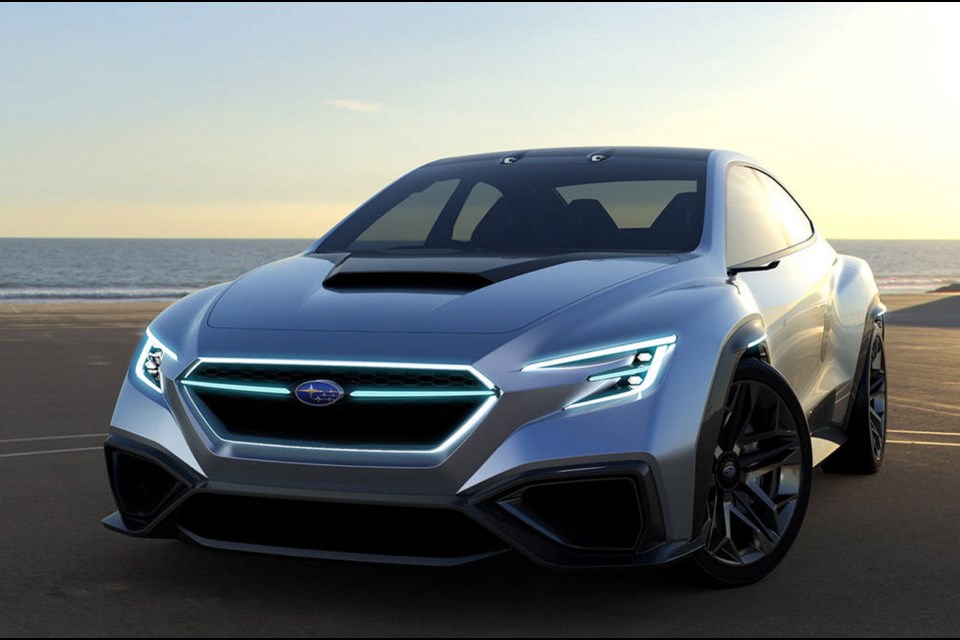Is Subaru getting out of the “boxer” engine business?
That’s a distinct possibility, according to intel being forwarded to the Sleuth’s electronic in-basket. All the automaker’s current offerings come with horizontally opposed — boxer — engines (one bank of two pistons fires 180 degrees to the second bank of two pistons, with the crankshaft in the middle). Word has it that the next-generation Subaru WRX and WRX STI (based on the Visiv Performance concept) that’s due to launch for the 2020 model year might go a different route. The problem, say some Subie sources, is that the boxer engine doesn’t lend itself to ever-tightening CO2-emissions regulations that could directly impact the high-output WRX and STI. It could be some time, however, before the less-potent four-and six-cylinder engine lineup is similarly changed to a new (and likely more conventional inline and V designs).
The Shelby GT500 is returning
It has been four years since Mustang buyers could opt for this powerhouse Mustang, but Ford says the wait will soon be over. The forthcoming super snake is now in the final testing phase and will arrive sometime this year as a 2019 model. The previous GT500 was fitted with a supercharged 5.8-litre V-8 that made 662 horsepower and 631 pound-feet of torque. The next-gen model will run with a smaller 5.2-litre V-8 (also supercharged), with a manufacturer-claimed output of more than 700 horsepower. A six-speed manual transmission will return, but a seven-speed paddle-shift gearbox originally developed for the ultra-expensive Ford GT sports car will be optional. Massive Brembo-brand brakes will be part of the GT500 package as will fender-filling 20-inch wheels. There’s no official word on pricing, but The Spymaster believes that $80,000 should cover it.
VW readies a new compact utility model
It seems that an increasing number of automakers have new small-and-tall wagon entries, or are about to join the fray. This group includes Volkswagen with a vehicle currently called the T-Cross. The Spy Guy’s operatives report that this little five-passenger model (that slots in below the Tiguan) will be similar in size to the Hyundai Kona and Toyota C-HR. It’s also expected that the 150-horsepower turbocharged 1.4-litre four-cylinder engine (currently installed in the VW Jetta sedan) will be a T-Cross staple. Look for front- and all-wheel-drive versions to arrive this fall.
BMW is expanding its i-car range
The Sleuth hears that, much like most other automakers, BMW plans to ramp up the number of electrified models that will supplement the current compact i3 hatchback and i8 sports car. The next to arrive sometime in 2020 is the i9 luxury sedan, which will have a reported range of up to 400 miles (640 kilometres) on a single charge of the battery. Closely following will be iX-branded vehicles that will come in wagon shapes much like the current gasoline-powered X1, X3 and X5. What’s unclear at this point is whether the i variants will be available with small range-extending gasoline-powered electric generators, much like the one used in the tiny i3. What’s a virtual certainty, however, is that BMW’s i-series will offer the latest autonomous (self-driving) technology.
A new Lexus subcompact could be bound for North America
It’s no secret that Toyota’s premium division has plans for a new UX utility wagon (smaller than the compact NX) for the European market, but not here. The Sleuth is now hearing that growing demand for such vehicles on this continent is causing Toyota to rethink those plans. The automaker’s U.S. and Canadian dealer groups are also pushing for the UX, which would help them compete against the BMW X1, Audi Q3 and Infiniti QX30. Pending approval, the UX could go on sale in North America by mid-2019 as a 2020 model.
Hyundai’s plan for an A.I.-driving-partner option
The South Korea-based automaker unveiled its “Intelligent Personal Agent” at the 2018 CES show in early January in Las Vegas, Nevada. The interactive system, which could be available as soon as 2019, can understand various driver commands and interact with smart home controls such as heating and lighting functions. The system can issue appointment reminders and can also issue the automatic advisories regarding road and traffic conditions.
Remembering a Mazda legend
Kenichi Yamamoto, who is credited with championing the automaker’s pistonless powerplant and turning it into a commercial success, was 95 when he died Dec. 20, 2017. The first rotary model, the Mazda R360, was introduced to the Japanese market in 1960, followed by several other models that were sold worldwide. Yamamoto was also responsible for the non-rotary-powered MX-5 Miata.



